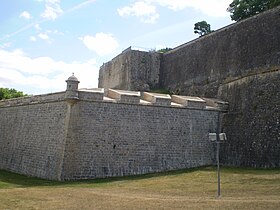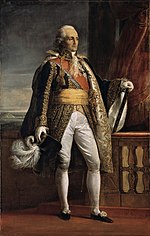Army of the Western Pyrenees
| Army of the Western Pyrenees | |
|---|---|
 The defenses of Pamplona, the object of French advances, remained in Spanish control during the war. | |
| Active | 1793–1795 |
| Country | |
| Type | Army |
| Role | Operations in Basque Country and Navarre |
| Engagements | War of the Pyrenees |
| Commanders | |
| Notable commanders | Jacques Léonard Muller Bon-Adrien de Moncey |
The Army of the Western Pyrenees (Armée des Pyrénées occidentales) was one of the
The army commanders with the longest tenure were Jacques Léonard Muller, who served from October 1793 to August 1794, and Bon-Adrien Jeannot de Moncey, who served from August 1794 until the army was disbanded. Emperor Napoleon appointed Moncey a Marshal of France in 1804 during the First French Empire.
Organisation
The

An order of battle for 1793 listed two battalions each of the 20th, 80th, and 148th Line Infantry
The first amalgame began in 1793 and by 5 September five demi-brigades were created with a nominal strength of 2,437 men and divided into three battalions of 812 soldiers. Eventually, 18 more demi-brigades were formed, giving the army a total of 60,000 men. Of these, probably one-third served in garrisons and were of lower quality. Because it was difficult to procure forage, the cavalry was perpetually understrength and about two-thirds of the horses died during the course of the war. Fortunately, the terrain did not lend itself to operations by mounted troops. Military transport and the artillery also suffered from the problem of inadequate forage and never had enough horses. The artillery arm was built up from scratch into a considerable force thanks largely to the capture of 535 Spanish guns and the efforts of the army's artillery chief Augustin de Lespinasse. He also created a pontoon train and units of artisans who repaired muskets taken from the Spaniards. Another innovation of the Army of the Western Pyrenees was its organization of work companies. While the army's soldiers initially suffered due to lack of supplies, by the end of the war the troops were well equipped by their logistical base at Bayonne.[5]
Because Servan was associated with

In July 1793, the Army of the Western Pyrenees numbered 28,000 infantry, 1,500 gunners and 700 cavalry. Muller organized the army which was something it previously lacked. In January 1794 he sent reinforcements totaling 8,000 to the War in the Vendée under Dumas and to the Army of the Eastern Pyrenees. Despite this subtraction the army counted 40 battalions that month. Of these, the 26 best battalions were formed into three divisions under Moncey, Henri François Delaborde, and Jean Henri Guy Nicolas de Frégeville. The remaining 14 battalions were assigned to two new divisions under Jean-Antoine Marbot and Jean Mauco, and were posted on the left wing. Muller's promotion to general of division finally came through on 14 April 1794.[7]

The army won a significant victory in the Battle of the Baztan Valley in July 1794.[8] Worn out by disputes with the overbearing representatives Jean-Baptiste Cavaignac and Jacques Pinet, Muller resigned his post since his triumph kept him safe from the guillotine.[9] Moncey was promoted to army command after his brilliant success in capturing San Sebastián on 3 August 1794. He enjoyed good luck in that the Reign of Terror ended on 27 July 1794, and with it the French government's practice of executing unsuccessful generals.[10] Despite his modest protest that he was unsuited to high command, Muller and the representatives recommended Moncey over more senior generals. The government approved the appointment on 17 August[11] and Moncey assumed command on 1 September.[12]
Though Cavaignac, Pinet and Pierre-Arnaud Dartigoeyte were soon replaced, the new representatives such as Pierre-Anselm Garrau also tended to meddle in military decisions.[13] As troublesome as the representatives could be, it is also true that no Army of the Western Pyrenees army commander was guillotined.[14] The army was supposed to be reinforced from the Vendée by 15,000 troops but only 3,000 foot soldiers and 500 horsemen arrived in mid-September.[13] For the fall 1794 offensive, Moncey's army numbered 52,000 troops in 64 battalions and four cavalry regiments.[15] During the winter, an epidemic killed 3,000 soldiers and many inhabitants in the occupied areas of Spain.[16]
Moncey reorganized his army so that each regiment had two field battalions while the third battalion, which had the poorest material, served on garrison duty. He detached
Operations

At the beginning of the War of the Pyrenees, the Spanish government decided to attack in the eastern Pyrenees while holding in the west. The Spanish had 8,000 regulars and between 9,000 and 10,000 militia in Navarre and Gipuzkoa, while from 4,000 to 5,000 troops held Aragon. The Spanish commander in the west, Ventura Caro mounted a quick offensive across the lower Bidasoa River near Hendaye. The French volunteers panicked and ran away, allowing their opponents to capture the Camp de Jolimont by 30 April 1793. For this defeat, the French general Joseph Duverger was arrested and sent to Paris. Servan pulled his troops behind the Nivelle River with his right wing at Bidart. While awaiting reinforcements behind a screen of regular and reliable volunteer units, the French commander began drilling his conscripts and raw volunteers. Massing the army's grenadier companies into one body under Théophile Corret de la Tour d'Auvergne, Servan sent them to recapture Saint-Pée-sur-Nivelle. This move was followed by a tentative advance in May.[19]
On 27 May 1793 Servan sent a force under Pierre François Lambert Lamoureux de Genettière to threaten the
On 5 February 1794 in the Battle of Sans Culottes Camp, Frégeville successfully defended the camp against 13,700 Spanish troops led by Urrutia.[24] On 3 June, a 2,300-man French brigade led by Lavictoire, part of Mauco's division, stormed the Izpegi Pass. The 1,000 defenders included Spanish and French royalist soldiers. The same day, Jacques Lefranc seized the Izpegi Ridge and other French troops captured positions near the Maya Pass.[25] On 23 June Ventura Caro's 8,500 Spanish soldiers were repulsed by a French force defending the fortified Mont Calvaire.[26] On 10 July Antoine Digonet's 4,000-strong brigade drove the Spanish and French Royalists from their defenses atop Monte Argintzo (Arquinzu). The French massacred 49 captured French Royalist prisoners while Marquis de Saint-Simon escaped, though badly wounded.[27]

On 23 July, the Army of the Western Pyrenees opened the Battle of the Baztan Valley by attacking the Spanish with the three front-line divisions of Moncey, Delaborde and Frégeville.
Moncey gained another victory in the Battle of Orbaizeta on 15–17 October 1794.[29] Frégeville advanced toward Lekunberri while Delaborde marched over the Belate Pass, defeating Antonio Filanghieri's 2,000 troops. On the 16th Delaborde and Jean Castelbert de Castelverd beat 4,000 Spaniards at Eugi and the next day drove them farther east. At the same time Moncey with the divisions of Marbot and Mauco moved against Manuel Cagigal at Roncevaux Pass. After Cagigal was forced back on Orbaizeta, Pedro Téllez-Girón, 9th Duke of Osuna ordered a general retreat to avoid encirclement, leaving behind 1,500 prisoners and 40 field pieces. The weather then closed in, preventing Moncey from fully exploiting his triumph,[30] though the French captured Bergara on 7 November.[31] There were rumors of peace and Servan came to Bayonne as an emissary.[16]
The summer of 1795 found the Prince of Castelfranco leading the Spanish army in Navarre, Gipuzkoa and Aragon. To protect his left, he placed Filanghieri with 9,000 regulars at Lekunberri and Crespo with 9,000 regulars guarding
Footnotes
- ^ Phipps 2011, p. 133.
- ^ Beckett 1987, p. 303.
- ^ Smith 1998, p. 41.
- ^ Phipps 2011, p. 134.
- ^ Phipps 2011, p. 135.
- ^ Phipps 2011, pp. 146–147.
- ^ a b Phipps 2011, pp. 148–149.
- ^ a b c Smith 1998, p. 88.
- ^ Phipps 2011, p. 187.
- ^ Beckett 1987, pp. 300–301.
- ^ Phipps 2011, p. 188.
- ^ Clerget 1905, p. 40.
- ^ a b Phipps 2011, p. 189.
- ^ a b c Phipps 2011, p. 209.
- ^ Phipps 2011, p. 190.
- ^ a b Phipps 2011, p. 193.
- ^ Phipps 2011, pp. 202–203.
- ^ Clerget 1905, p. 49.
- ^ Phipps 2011, pp. 144–145.
- ^ a b Cust 1859, p. 131.
- ^ a b Phipps 2011, p. 146.
- ^ Phipps 2011, p. 147.
- ^ Cust 1859, pp. 171–172.
- ^ Smith 1998, p. 72.
- ^ Smith 1998, p. 83.
- ^ Smith 1998, p. 85.
- ^ Smith 1998, p. 87.
- ^ a b Phipps 2011, pp. 186–187.
- ^ Smith 1998, pp. 93–94.
- ^ Cust 1859, pp. 266–267.
- ^ Smith 1998, p. 95.
- ^ Phipps 2011, pp. 204–206.
References
- Beckett, Ian F. W. (1987). "Moncey: An Honest Man". In ISBN 0-02-905930-5.
- Clerget, Charles (1905). Tableaux des Armées Francaises pendant les Guerres de la Révolution (in French). Paris: Libraire Militaire R. Chapelot et Cie. Retrieved 7 May 2015.
- Cust, Edward (1859). "Annals of the Wars: 1783-1795". Retrieved 9 May 2015.
- ISBN 978-1-908692-26-9.
- ISBN 1-85367-276-9.
- Broughton, Tony (2006). "Generals Who Served in the French Army during the Period 1789-1815". The Napoleon Series. Retrieved 9 May 2015.
